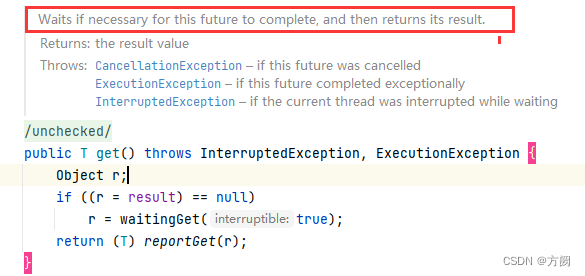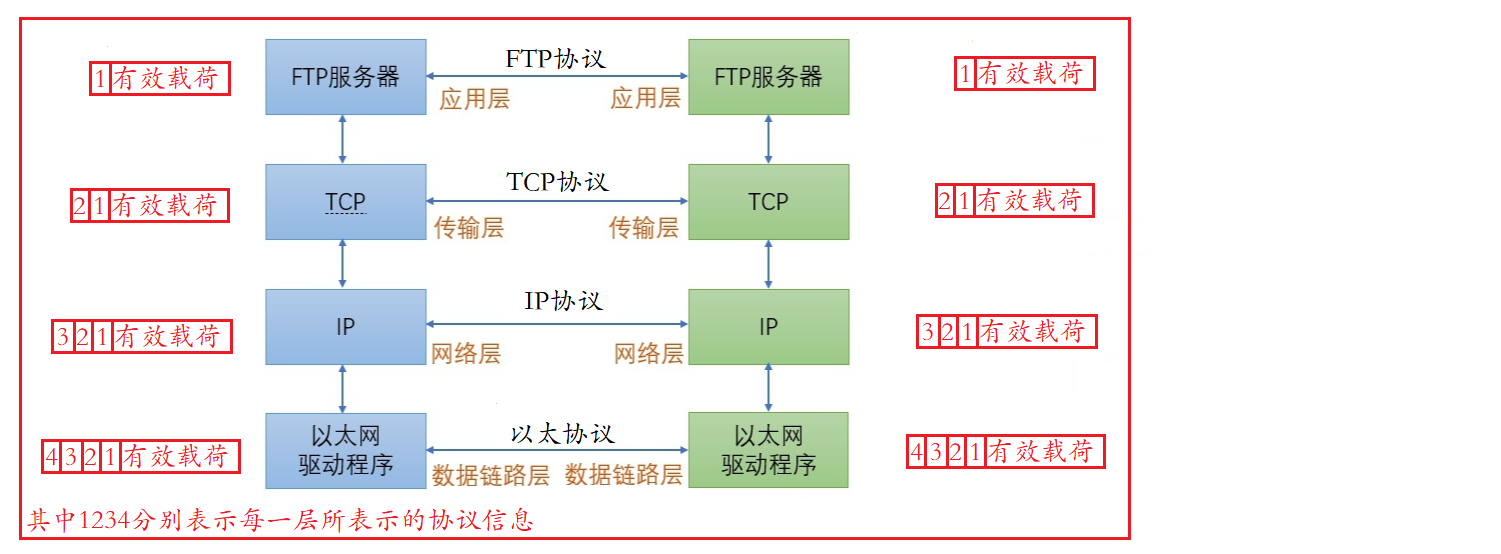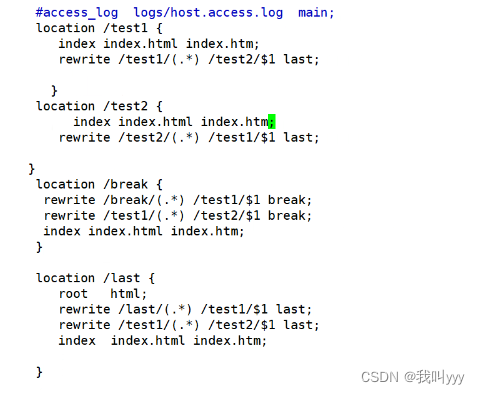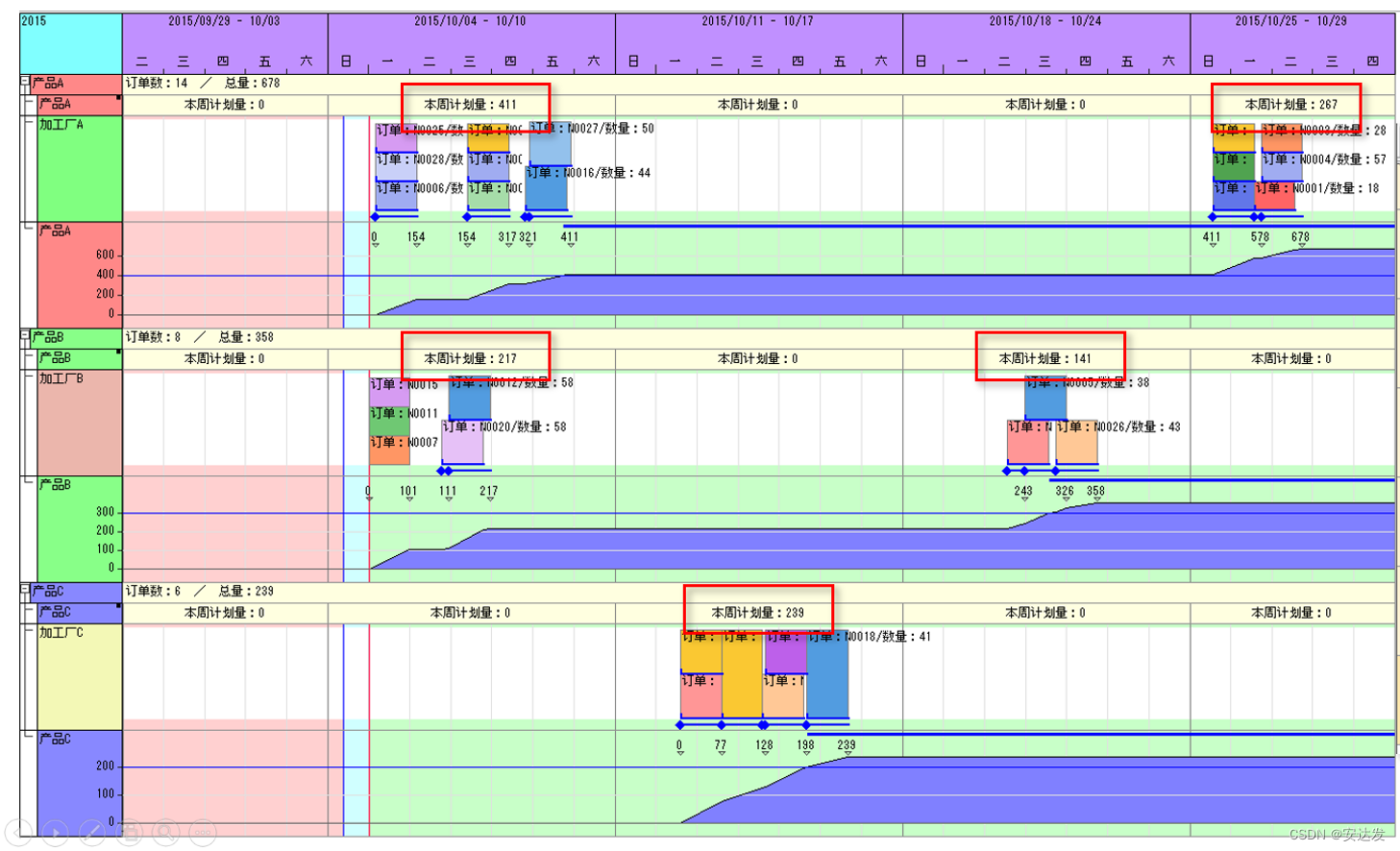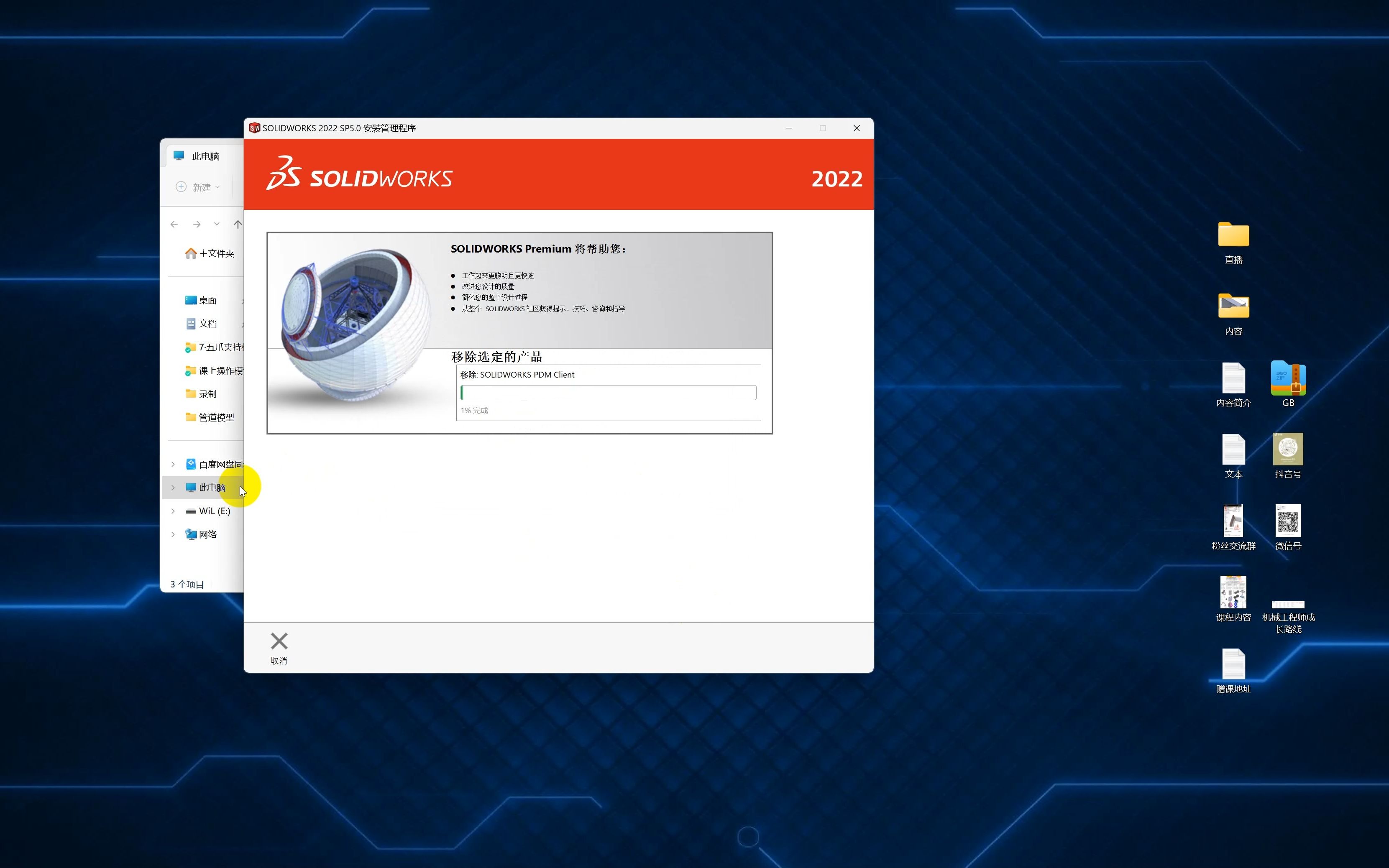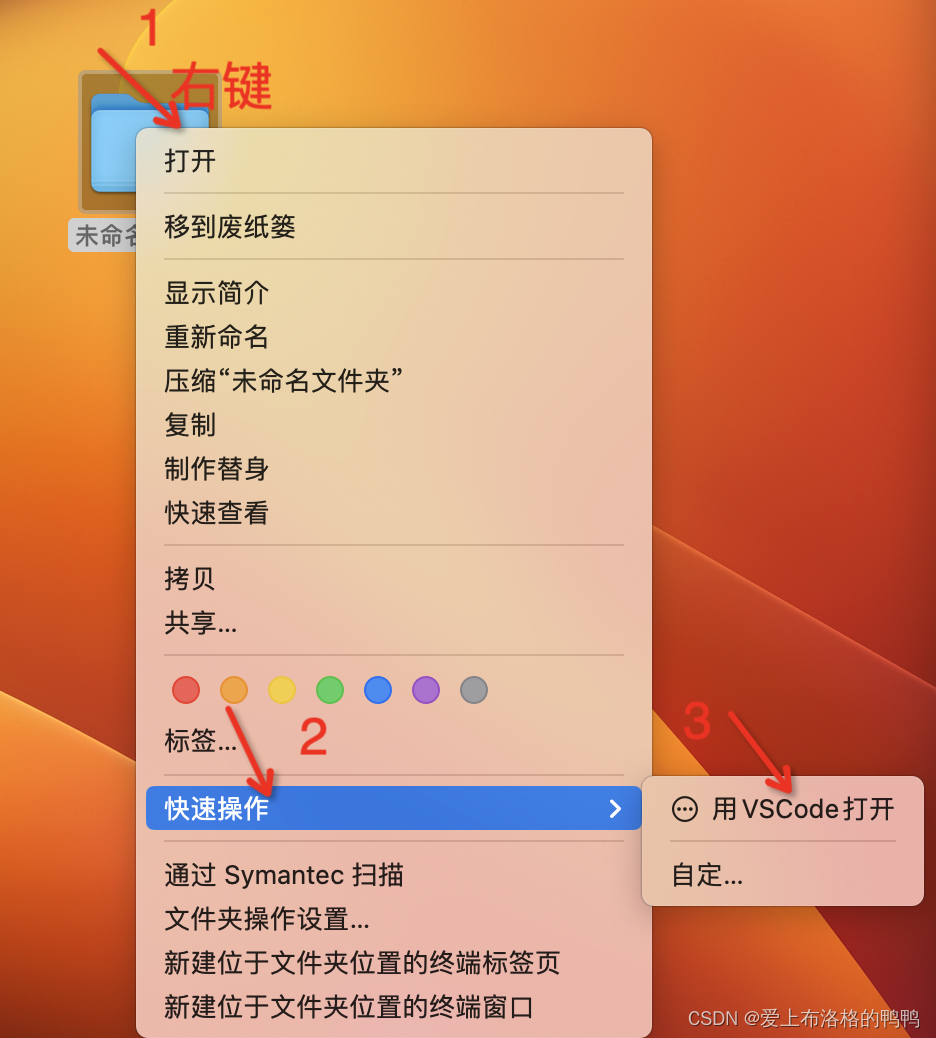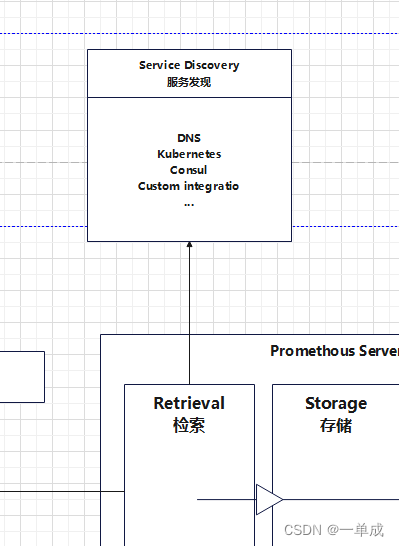本文将使用安富莱的STM32H743XIH板子驱动SDRAM
引脚连接情况

一、CubeMx配置工程

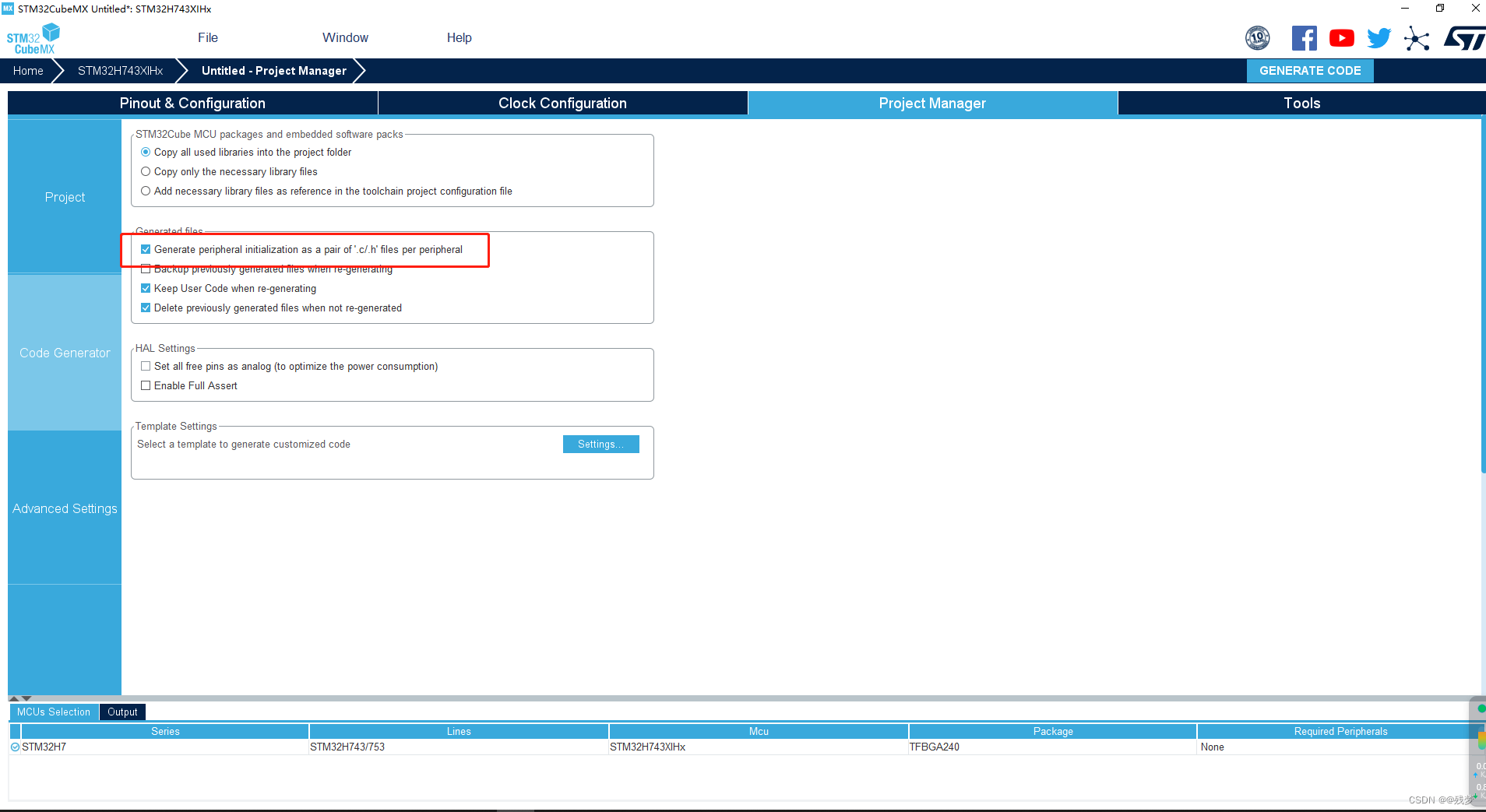
1、开启调试口

2、开启外部高速时钟
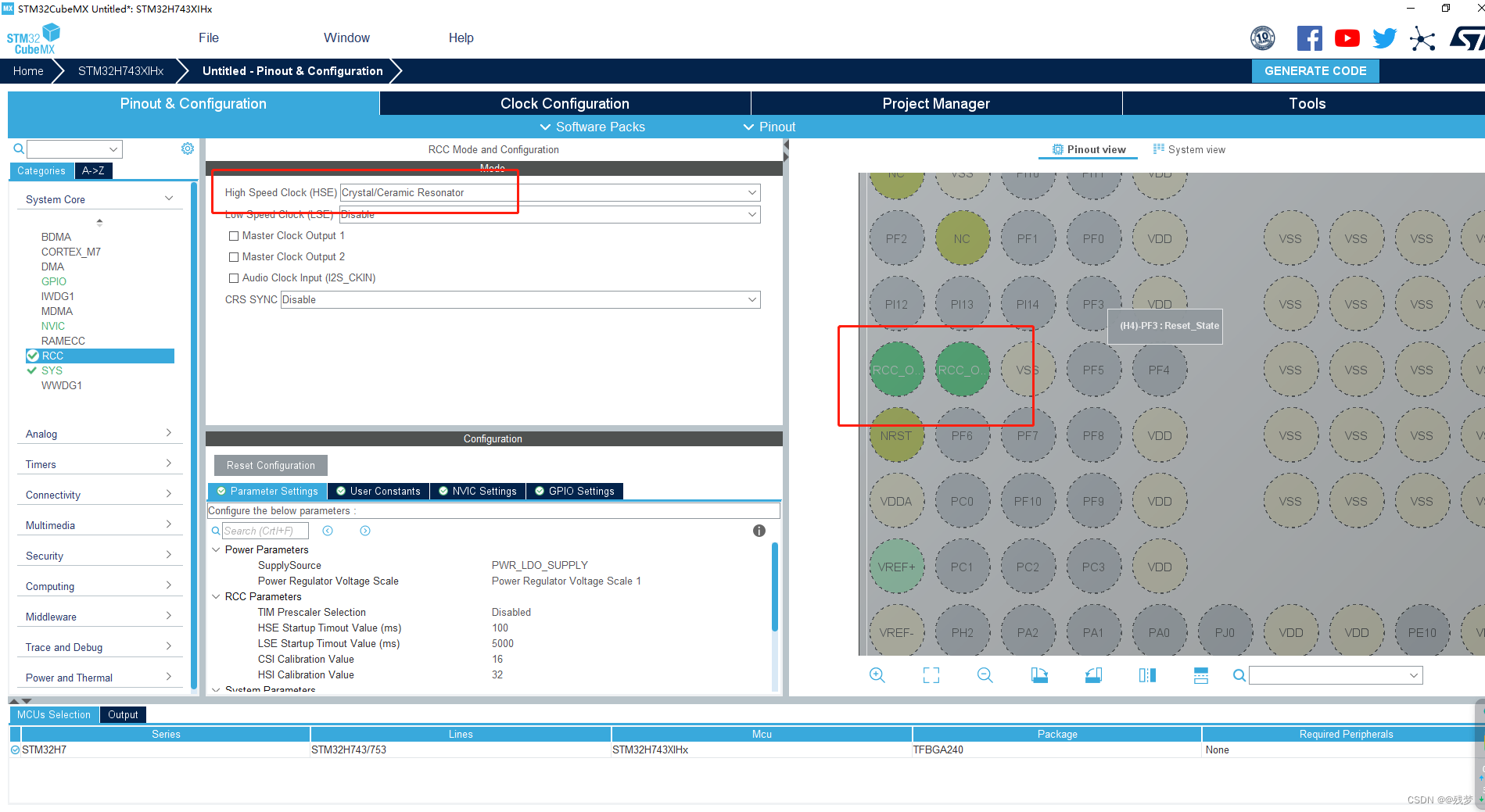
配置时钟树
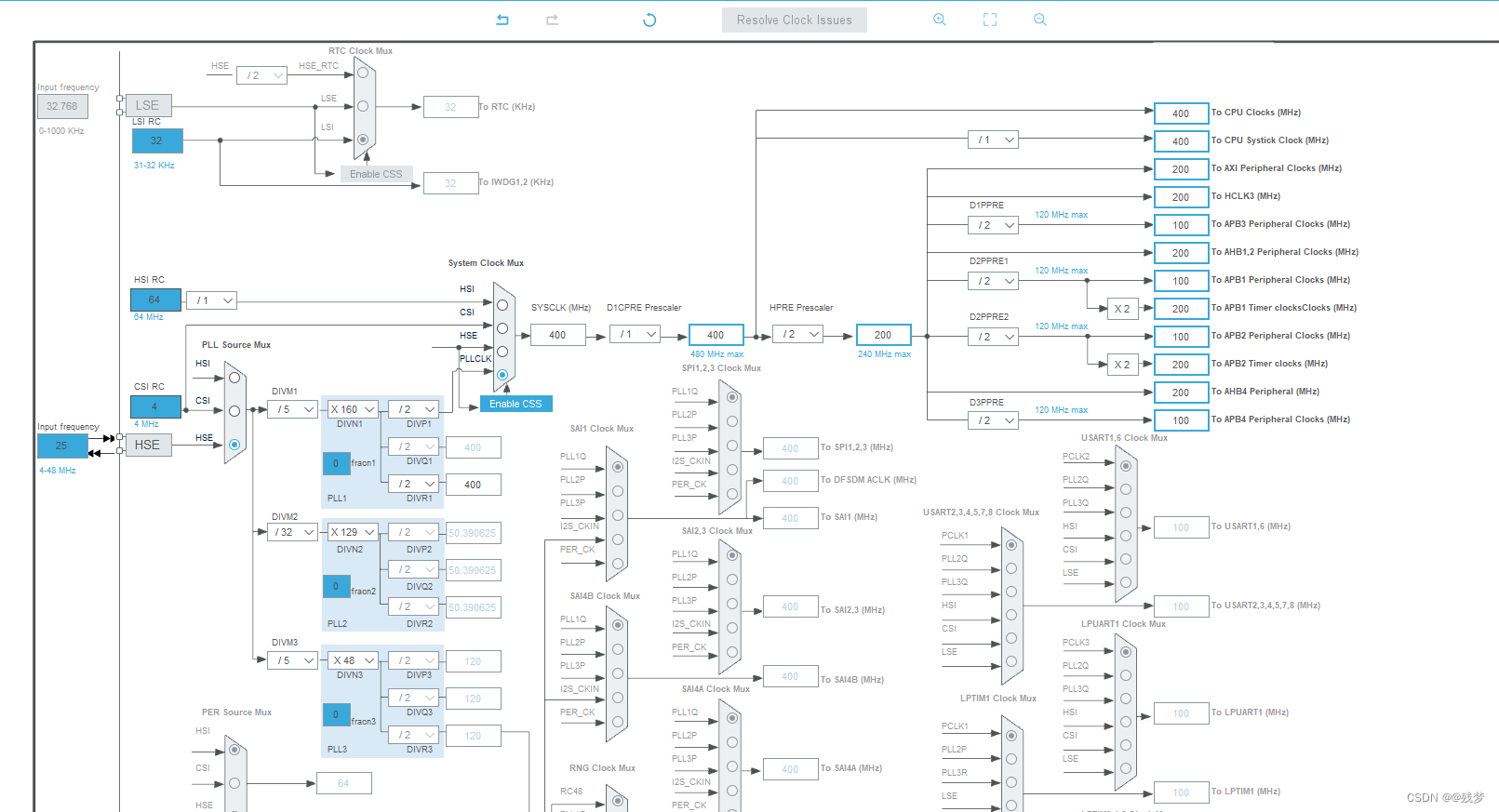
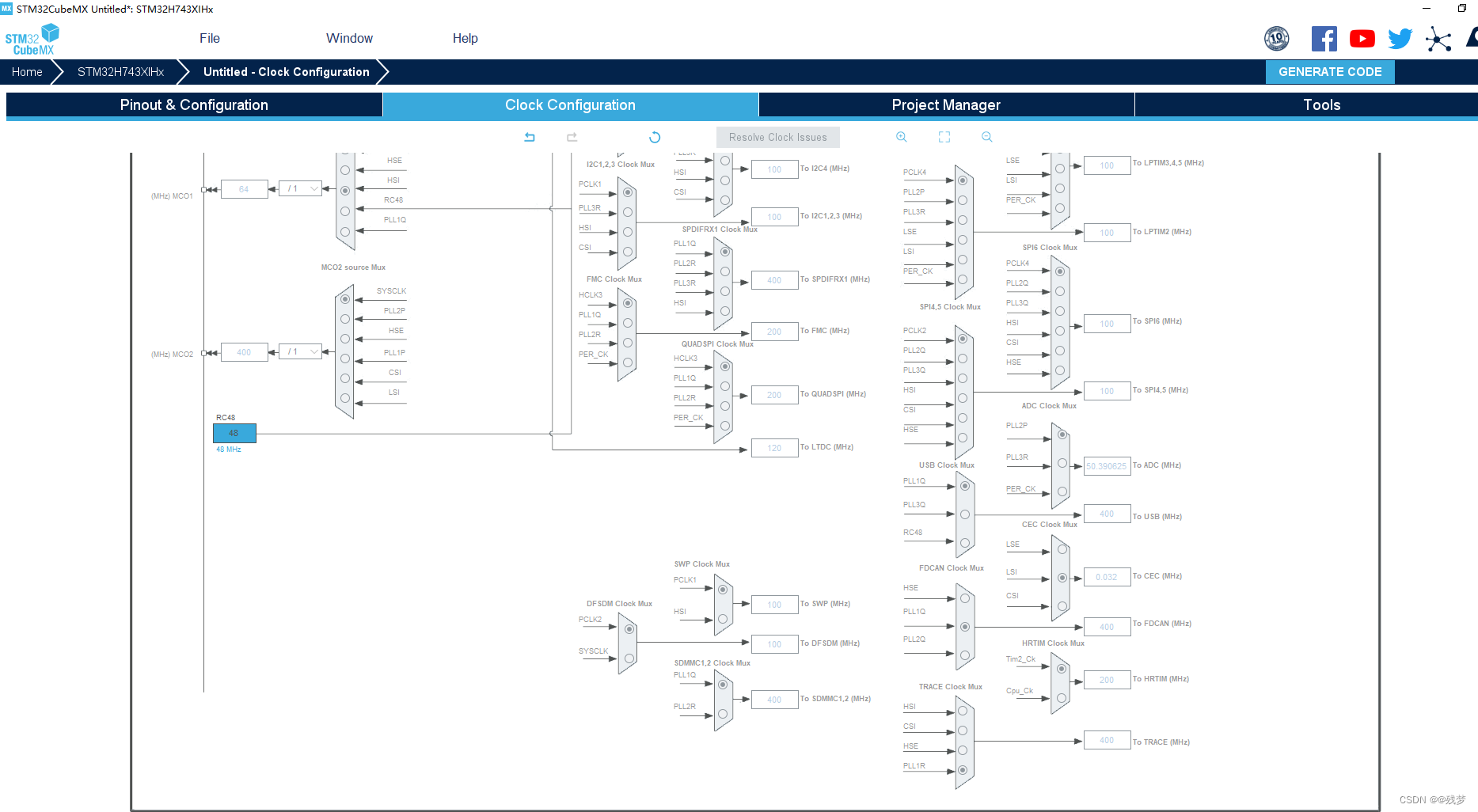
3、开启串口1

4、配置MPU
按照安富莱的例程配置:
/*
*********************************************************************************************************
* 函 数 名: MPU_Config
* 功能说明: 配置MPU
* 形 参: 无
* 返 回 值: 无
*********************************************************************************************************
*/
static void MPU_Config( void )
{
MPU_Region_InitTypeDef MPU_InitStruct;
/* 禁止 MPU */
HAL_MPU_Disable();
/* 配置AXI SRAM的MPU属性为Write back, Read allocate,Write allocate */
MPU_InitStruct.Enable = MPU_REGION_ENABLE;
MPU_InitStruct.BaseAddress = 0x24000000;
MPU_InitStruct.Size = MPU_REGION_SIZE_512KB;
MPU_InitStruct.AccessPermission = MPU_REGION_FULL_ACCESS;
MPU_InitStruct.IsBufferable = MPU_ACCESS_BUFFERABLE;
MPU_InitStruct.IsCacheable = MPU_ACCESS_CACHEABLE;
MPU_InitStruct.IsShareable = MPU_ACCESS_NOT_SHAREABLE;
MPU_InitStruct.Number = MPU_REGION_NUMBER0;
MPU_InitStruct.TypeExtField = MPU_TEX_LEVEL1;
MPU_InitStruct.SubRegionDisable = 0x00;
MPU_InitStruct.DisableExec = MPU_INSTRUCTION_ACCESS_ENABLE;
HAL_MPU_ConfigRegion(&MPU_InitStruct);
/* 配置FMC扩展IO的MPU属性为Device或者Strongly Ordered */
MPU_InitStruct.Enable = MPU_REGION_ENABLE;
MPU_InitStruct.BaseAddress = 0x60000000;
MPU_InitStruct.Size = ARM_MPU_REGION_SIZE_64KB;
MPU_InitStruct.AccessPermission = MPU_REGION_FULL_ACCESS;
MPU_InitStruct.IsBufferable = MPU_ACCESS_BUFFERABLE;
MPU_InitStruct.IsCacheable = MPU_ACCESS_NOT_CACHEABLE; /* 不能用MPU_ACCESS_CACHEABLE;会出现2次CS、WE信号 */
MPU_InitStruct.IsShareable = MPU_ACCESS_NOT_SHAREABLE;
MPU_InitStruct.Number = MPU_REGION_NUMBER1;
MPU_InitStruct.TypeExtField = MPU_TEX_LEVEL0;
MPU_InitStruct.SubRegionDisable = 0x00;
MPU_InitStruct.DisableExec = MPU_INSTRUCTION_ACCESS_ENABLE;
HAL_MPU_ConfigRegion(&MPU_InitStruct);
/* 配置SDRAM的MPU属性为Write back, Read allocate,Write allocate */
MPU_InitStruct.Enable = MPU_REGION_ENABLE;
MPU_InitStruct.BaseAddress = 0xC0000000;
MPU_InitStruct.Size = MPU_REGION_SIZE_32MB;
MPU_InitStruct.AccessPermission = MPU_REGION_FULL_ACCESS;
MPU_InitStruct.IsBufferable = MPU_ACCESS_BUFFERABLE;
MPU_InitStruct.IsCacheable = MPU_ACCESS_CACHEABLE;
MPU_InitStruct.IsShareable = MPU_ACCESS_NOT_SHAREABLE;
MPU_InitStruct.Number = MPU_REGION_NUMBER2;
MPU_InitStruct.TypeExtField = MPU_TEX_LEVEL1;
MPU_InitStruct.SubRegionDisable = 0x00;
MPU_InitStruct.DisableExec = MPU_INSTRUCTION_ACCESS_ENABLE;
HAL_MPU_ConfigRegion(&MPU_InitStruct);
/*使能 MPU */
HAL_MPU_Enable(MPU_PRIVILEGED_DEFAULT);
}
/*
*********************************************************************************************************
* 函 数 名: CPU_CACHE_Enable
* 功能说明: 使能L1 Cache
* 形 参: 无
* 返 回 值: 无
*********************************************************************************************************
*/
static void CPU_CACHE_Enable(void)
{
/* 使能 I-Cache */
SCB_EnableICache();
/* 使能 D-Cache */
SCB_EnableDCache();
}

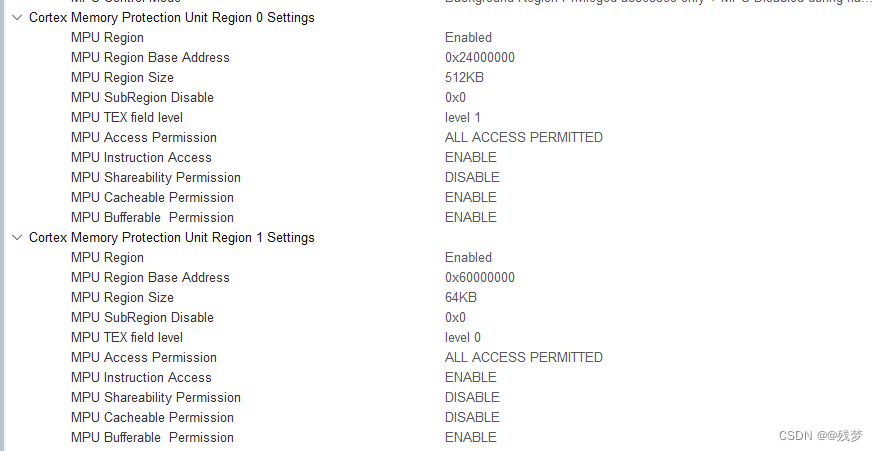

5、配置FMC


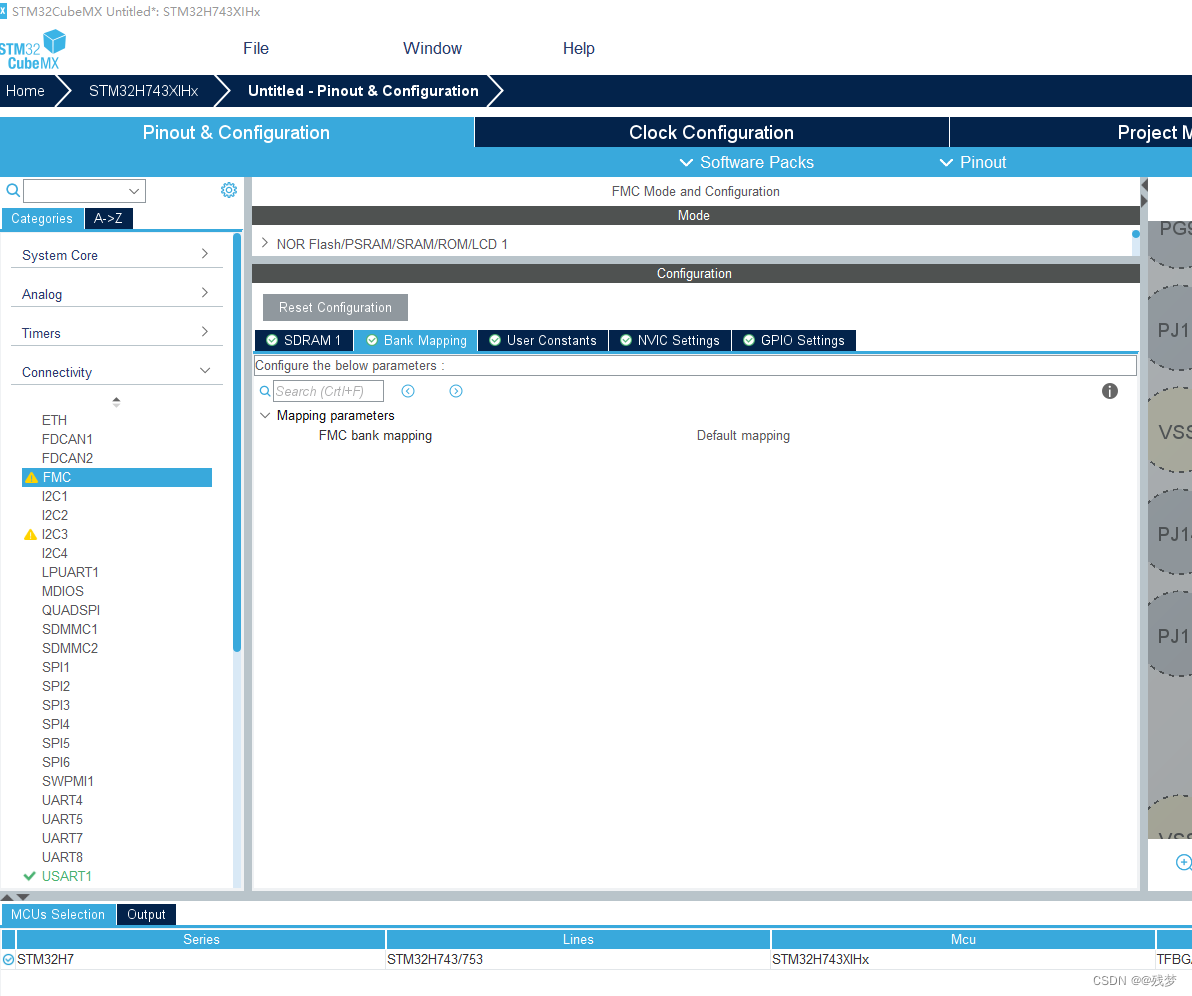
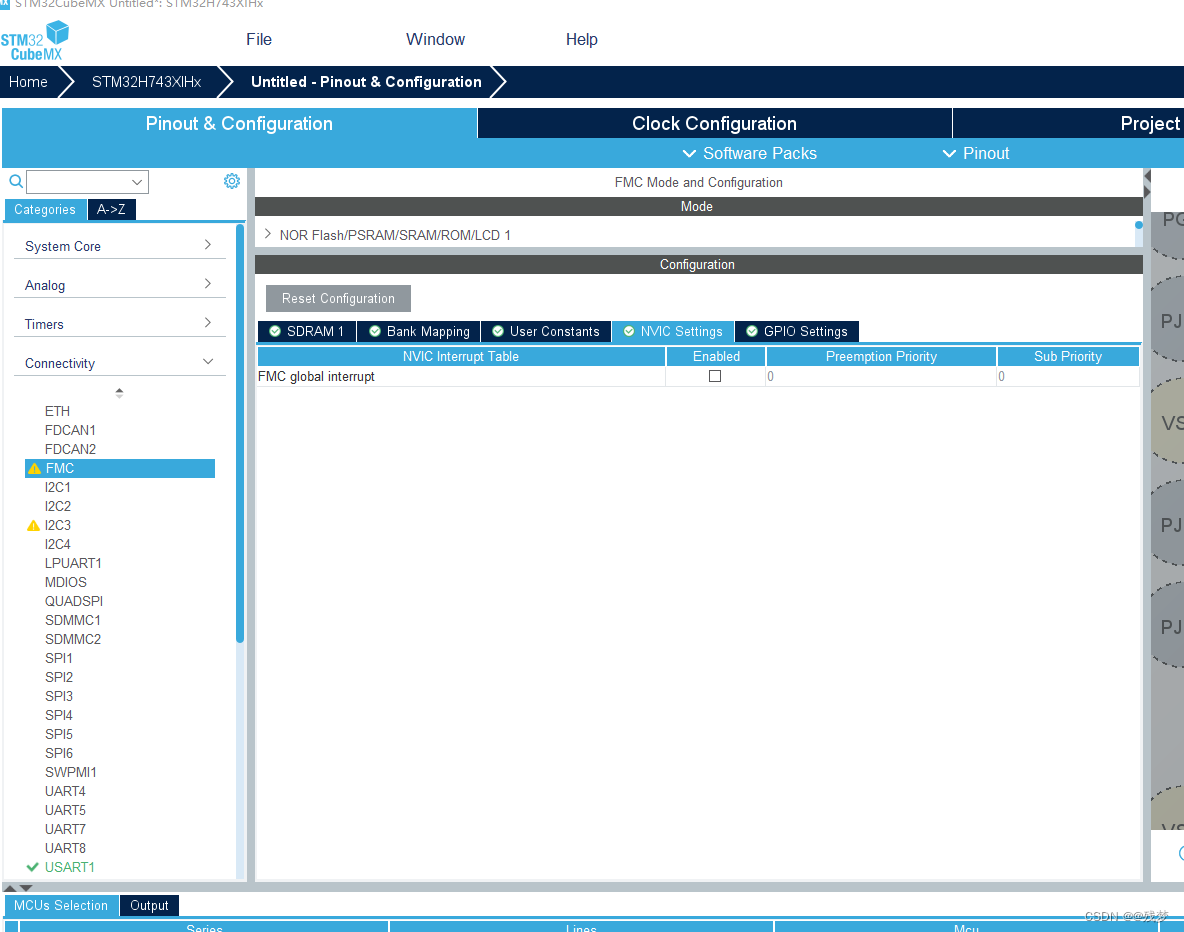
调整引脚和硬件接线图一致
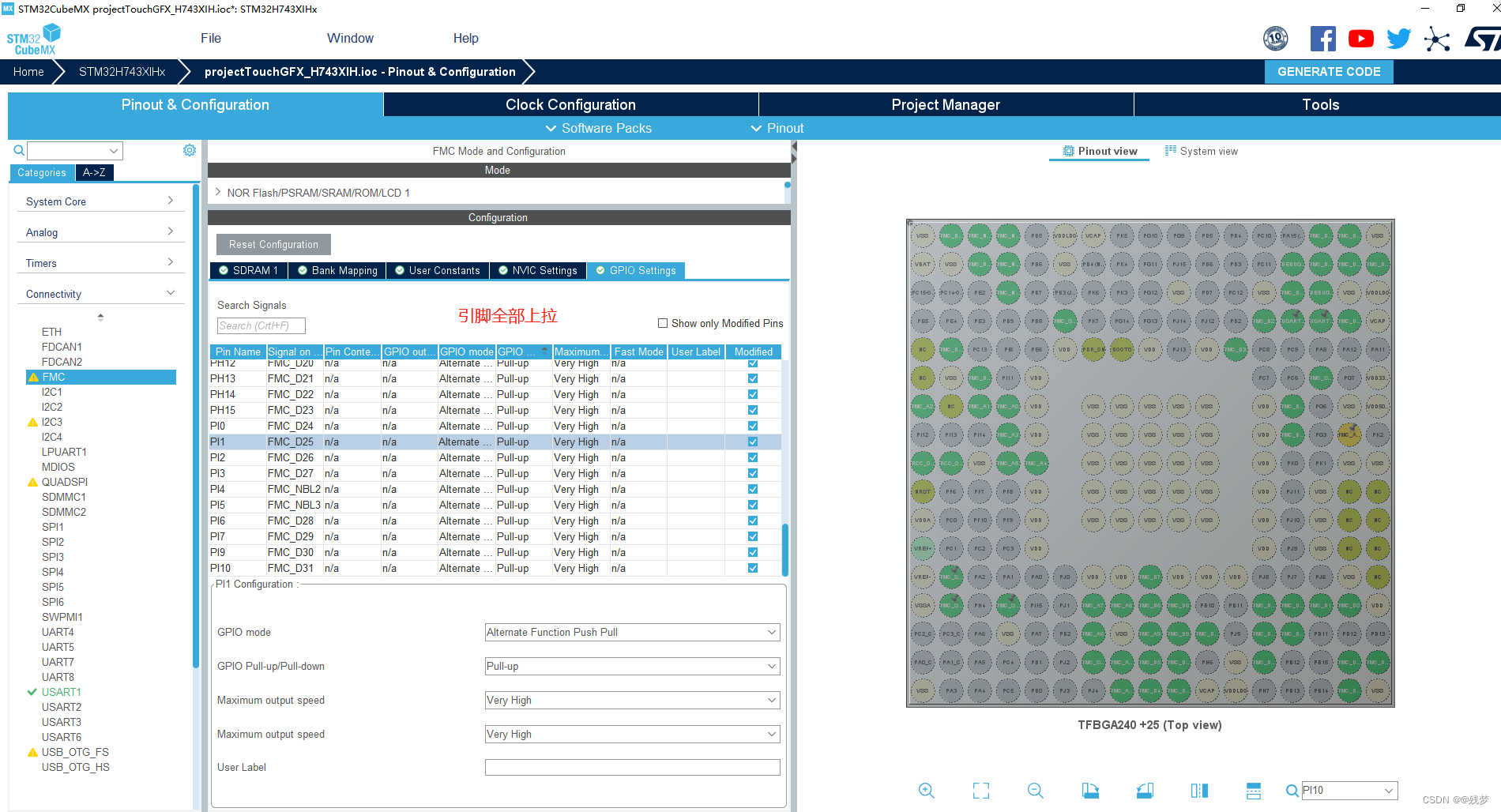
注意FMC时钟
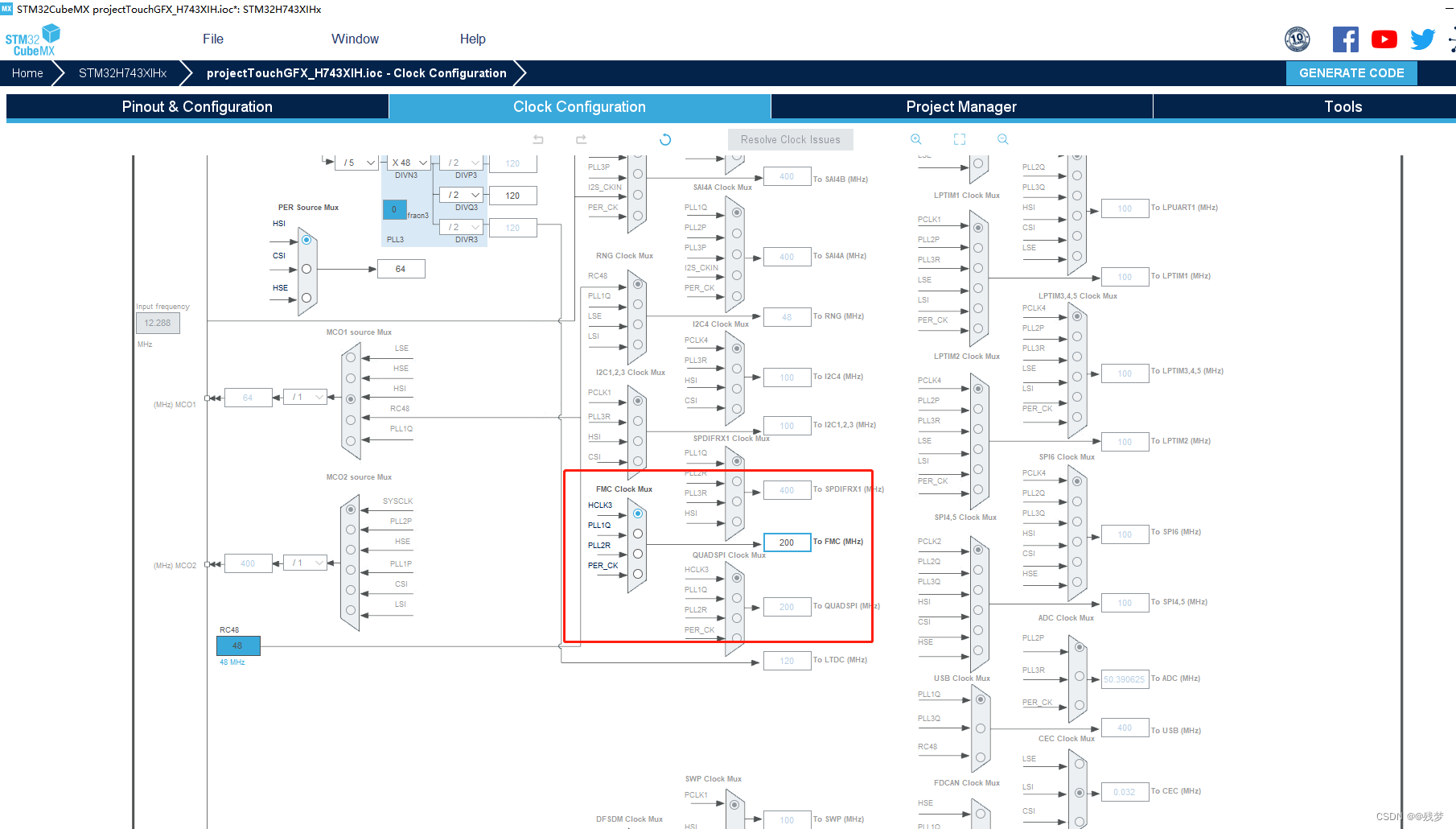
生成代码工程…
二、编写代码
1、添加文件至工程
common_driver.c|common_driver.h
bsp.c|bsp.h
sdram_driver.c|sdram_driver.h
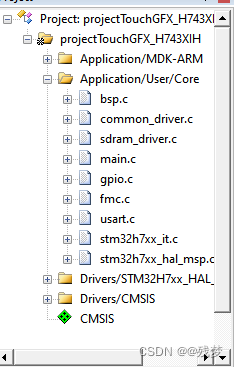
common_driver.h
#ifndef _common_driver_H_
#define _common_driver_H_
#ifdef __Cplusplus
#extern "C" {
#endif
//本文件使用宏的方式开启附加功能
#define dcommonEnable_STM32 //使能stm32功能
#define dcommonEnable_PID //使能PID功能
#include "stdint.h"
#include "stdlib.h"
#include "stdio.h"
#include "string.h"
#include "math.h"
#define dBOOL(x) (x?eStatus_Valid:eStatus_Invalid)//逻辑值:真-1,假-0
typedef uint8_t u8;
typedef uint16_t u16;
typedef uint32_t u32;
typedef int8_t s8;
typedef int16_t s16;
typedef int32_t s32;
typedef struct
{
unsigned char byte1;
unsigned char byte2;
unsigned char byte3;
unsigned char byte4;
}Byte4_MemoryParameterStructDef;
typedef struct
{
unsigned char byte1;
unsigned char byte2;
}Byte2_MemoryParameterStructDef;
typedef union
{
short int Value;
Byte2_MemoryParameterStructDef Memory;
}Convert_ShortIntParameter_UnionDef;
typedef union
{
unsigned short int Value;
Byte2_MemoryParameterStructDef Memory;
}Convert_UnsignedShortIntParameter_UnionDef;
typedef union
{
unsigned long int Value;
Byte4_MemoryParameterStructDef Memory;
}Convert_UnsignedLongIntParameter_UnionDef;
typedef union
{
float Value;
Byte4_MemoryParameterStructDef Memory;
}Convert_FloatParameter_UnionDef;
typedef struct
{
uint8_t hour;
uint8_t minute;
uint8_t second;
uint8_t millisecond;
}Time24Format_StructDef;
typedef enum
{
eStatus_Invalid = 0,
eStatus_Valid = 1
}status_EnumDef;
void LinearFitCoefficient(double *pA,double *pB,double x[],double y[],unsigned short int dataSize);
unsigned long int DichotomyFindPos(float target,float *pdata,unsigned long int len);
//STM32支持区
#ifdef dcommonEnable_STM32
#include "main.h"
#pragma diag_suppress 177 //忽略编译时函数定义但是没有引用的警告
#define dSET_PIN(GPIOx,Pin) GPIOx->BSRR = Pin //引脚置1
#define dRESET_PIN(GPIOx,Pin) GPIOx->BSRR = ((uint32_t)Pin << 16u) //引脚置0
#define dPIN_WRITE(GPIOx,Pin,x) GPIOx->BSRR = ((uint32_t)Pin << ((x)?0u:16u))
#define dPIN_READ(GPIOx,Pin) (GPIOx->IDR & Pin)?1:0 //获取引脚状态
#define dxPIN_MODE_IN(gpio,pin) {gpio->MODER &= ~(3<<(pin*2));gpio->MODER |= 0<<(pin*2);}//配置引脚为输入模式
#define dxPIN_MODE_OUT(gpio,pin) {gpio->MODER &= ~(3<<(pin*2));gpio->MODER |= 1<<(pin*2);}//配置引脚为输出模式
#define dPIN_TURN(GPIOx,Pin) HAL_GPIO_TogglePin(GPIOx,Pin)
#endif
//PID功能支持区
#ifdef dcommonEnable_PID
typedef struct
{
float target;//目标值
float actual;//当前输出值
float err;//本次偏差值
float err_last;//上一次偏差值
float err_next;//上上次的偏差值
float integral;//累计误差
float Kp;
float Ki;
float Kd;
}PID_ParameterStructDef;//PID参数结构体
float PID_realize_increment(PID_ParameterStructDef *pid,float actual_val,unsigned long int Min,unsigned long int Max);
float PID_realize_location(PID_ParameterStructDef *pid,float actual_val,unsigned long int Min,unsigned long int Max);
#endif
#ifdef __Cplusplus
}
#endif
#endif
common_driver.c
/**********************************************************************
*file:开发常用函数|宏文件
*author:残梦
*versions:V1.2
*date:2023.08.10
*note:
**********************************************************************/
#include "common_driver.h"
/*开始1、基础功能******************************************************/
/****************************************************
@function:计算数据的拟合系数
@param:*pA,*pB--系数
x[],y[]--数据源
dataSize--数据个数
@return:void
@note:拟合曲线y=Ax+B
****************************************************/
void LinearFitCoefficient(double *pA,double *pB,double x[],double y[],unsigned short int dataSize)
{
unsigned short int i= 0;
double AverX = 0.0f,AverY = 0.0f,a1 = 0.0f,a2 = 0.0f;
if(dataSize == 0){*pA = *pB = 0.0;return;}
else if(dataSize == 1){*pA = 0.0;*pB = y[0];return;}
while(i < dataSize) {AverX += x[i];AverY += y[i];i++;}
AverX /= (double)(dataSize);AverY /= (double)(dataSize);
a1 = a2 = 0.0f;
for(i=0;i<dataSize;i++)
{
a1 += (x[i] - AverX)*(y[i] - AverY);
a2 += (x[i] - AverX)*(x[i] - AverX);
}
*pA = a1/a2;
*pB = AverY - (*pA)*AverX;
}
/****************************************
@function:二分法查找target在数组pdata中的最相邻位置
@param:target--目标数据,pdata--源数据,len--源数据长度
@return:[0,len-1]
@note:
****************************************/
unsigned long int DichotomyFindPos(float target,float *pdata,unsigned long int len)
{
unsigned long int pos = 0,posl = 0,posr = 0;
unsigned char flag = 0;
//for(unsigned long int z = 0;z < len;z++){printf("[%d]=%f\n",z,*(pdata+z));}
if(len <= 2){return 0;}
//判定数据是否在区间外
flag = (*(pdata + len -1) > *pdata)?1:0;
if(flag == 1)//递增数据
{
if(target < *pdata)return 0;
else if(target > *(pdata + len -1))return (len -1);
}
else
{
if(target > *pdata)return 0;
else if(target < *(pdata + len -1))return (len -1);
}
unsigned long int num = 0;
//区间内的数据
posl = 0;posr = len -1;
while((posl != (posr-1)) && (posl != posr))
{
pos = (posr + posl)/2;
if(flag == 1)
{
if(target < (*(pdata + pos))){posr = pos;}
else{posl = pos;}
}
else
{
if(target > (*(pdata + pos))){posr = pos;}
else{posl = pos;}
}
num++;
//printf("%d [%d,%d]=[%f,%f]\n",num,posl,posr,*(pdata + posl),*(pdata + posr));
}
//printf("[pos,tar]=[%d,%f] num=%d\n",posl,target,num);
return posl;
}
/*结束****************************************************************/
/*开始1、STM32支持区***************************************************/
#ifdef dcommonEnable_STM32
#include "usart.h"
/******************************
@function:printf打印使用
@param:
@return:
@remark:
******************************/
int fputc(int ch,FILE *f)
{
unsigned char temp[1] = {ch};
HAL_UART_Transmit(&huart1,temp,1,2);
return(ch);
}
#endif
/*结束****************************************************************/
/*开始1、PID功能支持区*************************************************/
#ifdef dcommonEnable_PID
/****************************************
@function:增量式PID算法
@param: pid--PID_ParameterStructDef
actual_val--当前采集值
Min--输出限幅最小值
Max--输出限幅最大值
@return:
@note:
****************************************/
float PID_realize_increment(PID_ParameterStructDef *pid,float actual_val,unsigned long int Min,unsigned long int Max)
{
/*计算目标值与实际值的误差*/
pid->err=pid->target-actual_val;
/*PID算法实现*/
pid->actual += pid->Kp*(pid->err - pid->err_next)
+ pid->Ki*pid->err
+ pid->Kd*(pid->err - 2 * pid->err_next + pid->err_last);
/*传递误差*/
pid->err_last = pid->err_next;
pid->err_next = pid->err;
pid->actual = (pid->actual < Min)?Min:pid->actual;
pid->actual = (pid->actual > Max)?Max:pid->actual;
/*返回当前实际值*/
return pid->actual;
}
/****************************************
@function:位置式PID算法
@param: pid--PID_ParameterStructDef
actual_val--当前采集值
Min--输出限幅最小值
Max--输出限幅最大值
@return:
@note:
****************************************/
float PID_realize_location(PID_ParameterStructDef *pid,float actual_val,unsigned long int Min,unsigned long int Max)
{
/*计算目标值与实际值的误差*/
pid->err=pid->target-actual_val;
/*误差累积*/
pid->integral+=pid->err;
/*PID算法实现*/
pid->actual=pid->Kp*pid->err + pid->Ki*pid->integral + pid->Kd * (pid->err - pid->err_last);
/*误差传递*/
pid->err_last=pid->err;
pid->actual = (pid->actual < Min)?Min:pid->actual;
pid->actual = (pid->actual > Max)?Max:pid->actual;
return pid->actual;
}
#endif
bsp.h
#ifndef _bsp_H_
#define _bsp_H_
#ifdef __Cplusplus
#extern "C" {
#endif
#include "stdint.h"
int32_t bsp_init(void);
#ifdef __Cplusplus
}
#endif
#endif
bsp.c
/**********************************************************************
*file:板级支持包文件
*author:残梦
*versions:V1.0
*date:2023.08.10
*note:
**********************************************************************/
#include "bsp.h"
#include "common_driver.h"
/****************************************
@function:板硬件初始化
@param:void
@return:小于0--失败,0--成功
@note:
****************************************/
int32_t bsp_init(void)
{
return 0;
}
sdram_driver.h
#ifndef _sdram_driver_H_
#define _sdram_driver_H_
#ifdef __Cplusplus
#extern "C" {
#endif
#include "main.h"
#define EXT_SDRAM_ADDR ((uint32_t)0xC0000000)
#define EXT_SDRAM_SIZE (32 * 1024 * 1024)
/* LCD显存,第1页, 分配2M字节 */
#define SDRAM_LCD_BUF1 EXT_SDRAM_ADDR
/* LCD显存,第2页, 分配2M字节 */
#define SDRAM_LCD_BUF2 (EXT_SDRAM_ADDR + SDRAM_LCD_SIZE)
#define SDRAM_LCD_SIZE (2 * 1024 * 1024) /* 每层2M */
#define SDRAM_LCD_LAYER 2 /* 2层 */
/* 剩下的12M字节,提供给应用程序使用 */
#define SDRAM_APP_BUF (EXT_SDRAM_ADDR + SDRAM_LCD_SIZE * SDRAM_LCD_LAYER)
#define SDRAM_APP_SIZE (EXT_SDRAM_SIZE - SDRAM_LCD_SIZE * SDRAM_LCD_LAYER)
void SDRAM_Initialization_Sequence(SDRAM_HandleTypeDef *hsdram);
uint32_t bsp_TestExtSDRAM1(void);
#ifdef __Cplusplus
}
#endif
#endif
sdram_driver.c
/**********************************************************************
*file:外部SDRAM驱动文件:SDRAM型号IS42S32800G-6BLI, 32位带宽, 容量32MB, 6ns速度(166MHz)
*author:残梦
*versions:V1.0
*date:2023.06.02
*note:
-- 安富莱STM32-V7发板 SDRAM GPIO 定义
+-------------------+--------------------+--------------------+--------------------+
+ SDRAM pins assignment +
+-------------------+--------------------+--------------------+--------------------+
| PD0 <-> FMC_D2 | PE0 <-> FMC_NBL0 | PF0 <-> FMC_A0 | PG0 <-> FMC_A10 |
| PD1 <-> FMC_D3 | PE1 <-> FMC_NBL1 | PF1 <-> FMC_A1 | PG1 <-> FMC_A11 |
| PD8 <-> FMC_D13 | PE7 <-> FMC_D4 | PF2 <-> FMC_A2 | PG4 <-> FMC_A14 |
| PD9 <-> FMC_D14 | PE8 <-> FMC_D5 | PF3 <-> FMC_A3 | PG5 <-> FMC_A15 |
| PD10 <-> FMC_D15 | PE9 <-> FMC_D6 | PF4 <-> FMC_A4 | PG8 <-> FC_SDCLK |
| PD14 <-> FMC_D0 | PE10 <-> FMC_D7 | PF5 <-> FMC_A5 | PG15 <-> FMC_NCAS |
| PD15 <-> FMC_D1 | PE11 <-> FMC_D8 | PF11 <-> FC_NRAS |--------------------+
+-------------------| PE12 <-> FMC_D9 | PF12 <-> FMC_A6 | PG2 --- FMC_A12 (预留64M字节容量,和摇杆上键复用)
| PE13 <-> FMC_D10 | PF13 <-> FMC_A7 |
| PE14 <-> FMC_D11 | PF14 <-> FMC_A8 |
| PE15 <-> FMC_D12 | PF15 <-> FMC_A9 |
+-------------------+--------------------+--------------------+
| PH2 <-> FMC_SDCKE0| PI4 <-> FMC_NBL2 |
| PH3 <-> FMC_SDNE0 | PI5 <-> FMC_NBL3 |
| PH5 <-> FMC_SDNW |--------------------+
+-------------------+
+-------------------+------------------+
+ 32-bits Mode: D31-D16 +
+-------------------+------------------+
| PH8 <-> FMC_D16 | PI0 <-> FMC_D24 |
| PH9 <-> FMC_D17 | PI1 <-> FMC_D25 |
| PH10 <-> FMC_D18 | PI2 <-> FMC_D26 |
| PH11 <-> FMC_D19 | PI3 <-> FMC_D27 |
| PH12 <-> FMC_D20 | PI6 <-> FMC_D28 |
| PH13 <-> FMC_D21 | PI7 <-> FMC_D29 |
| PH14 <-> FMC_D22 | PI9 <-> FMC_D30 |
| PH15 <-> FMC_D23 | PI10 <-> FMC_D31 |
+------------------+-------------------+
+-------------------+
+ Pins remapping +
+-------------------+
| PC0 <-> FMC_SDNWE |
| PC2 <-> FMC_SDNE0 |
| PC3 <-> FMC_SDCKE0|
+-------------------+
hsdram1.Instance = FMC_SDRAM_DEVICE;
hsdram1.Init.SDBank = FMC_SDRAM_BANK1;
hsdram1.Init.ColumnBitsNumber = FMC_SDRAM_COLUMN_BITS_NUM_9;
hsdram1.Init.RowBitsNumber = FMC_SDRAM_ROW_BITS_NUM_12;
hsdram1.Init.MemoryDataWidth = FMC_SDRAM_MEM_BUS_WIDTH_32;
hsdram1.Init.InternalBankNumber = FMC_SDRAM_INTERN_BANKS_NUM_4;
hsdram1.Init.CASLatency = FMC_SDRAM_CAS_LATENCY_3;//CAS Latency可以设置Latency1,2和3,实际测试Latency3稳定
hsdram1.Init.WriteProtection = FMC_SDRAM_WRITE_PROTECTION_DISABLE;//禁止写保护
hsdram1.Init.SDClockPeriod = FMC_SDRAM_CLOCK_PERIOD_2;//FMC时钟200MHz,2分频后给SDRAM,即100MHz
hsdram1.Init.ReadBurst = FMC_SDRAM_RBURST_ENABLE;//使能读突发
hsdram1.Init.ReadPipeDelay = FMC_SDRAM_RPIPE_DELAY_0;//此位定CAS延时后延后多少个SDRAM时钟周期读取数据,实际测此位可以设置无需延迟
FMC使用的HCLK3时钟,200MHz,用于SDRAM的话,至少2分频,也就是100MHz,即1个SDRAM时钟周期是10ns
下面参数单位均为10ns。
Timing.LoadToActiveDelay = 2; 20ns, TMRD定义加载模式寄存器的命令与激活命令或刷新命令之间的延迟
Timing.ExitSelfRefreshDelay = 7; 70ns, TXSR定义从发出自刷新命令到发出激活命令之间的延迟
Timing.SelfRefreshTime = 4; 50ns, TRAS定义最短的自刷新周期
Timing.RowCycleDelay = 7; 70ns, TRC定义刷新命令和激活命令之间的延迟
Timing.WriteRecoveryTime = 2; 20ns, TWR定义在写命令和预充电命令之间的延迟
Timing.RPDelay = 2; 20ns, TRP定义预充电命令与其它命令之间的延迟
Timing.RCDDelay = 2; 20ns, TRCD定义激活命令与读/写命令之间的延迟
*********************************************************************/
#include "sdram_driver.h"
#define SDRAM_TIMEOUT ((uint32_t)0xFFFF)
#define REFRESH_COUNT ((uint32_t)1543) /* SDRAM自刷新计数 */
/* SDRAM的参数配置 */
#define SDRAM_MODEREG_BURST_LENGTH_1 ((uint16_t)0x0000)
#define SDRAM_MODEREG_BURST_LENGTH_2 ((uint16_t)0x0001)
#define SDRAM_MODEREG_BURST_LENGTH_4 ((uint16_t)0x0002)
#define SDRAM_MODEREG_BURST_LENGTH_8 ((uint16_t)0x0004)
#define SDRAM_MODEREG_BURST_TYPE_SEQUENTIAL ((uint16_t)0x0000)
#define SDRAM_MODEREG_BURST_TYPE_INTERLEAVED ((uint16_t)0x0008)
#define SDRAM_MODEREG_CAS_LATENCY_2 ((uint16_t)0x0020)
#define SDRAM_MODEREG_CAS_LATENCY_3 ((uint16_t)0x0030)
#define SDRAM_MODEREG_OPERATING_MODE_STANDARD ((uint16_t)0x0000)
#define SDRAM_MODEREG_WRITEBURST_MODE_PROGRAMMED ((uint16_t)0x0000)
#define SDRAM_MODEREG_WRITEBURST_MODE_SINGLE ((uint16_t)0x0200)
/****************************************************
@function:SDRAM初始化序列
@param:hsdram: SDRAM句柄
@return:void
@note:完成SDRAM序列初始化
****************************************************/
void SDRAM_Initialization_Sequence(SDRAM_HandleTypeDef *hsdram)
{
FMC_SDRAM_CommandTypeDef Command;
__IO uint32_t tmpmrd =0;
/*##-1- 时钟使能命令 ##################################################*/
Command.CommandMode = FMC_SDRAM_CMD_CLK_ENABLE;
Command.CommandTarget = FMC_SDRAM_CMD_TARGET_BANK1;;
Command.AutoRefreshNumber = 1;
Command.ModeRegisterDefinition = 0;
/* 发送命令 */
HAL_SDRAM_SendCommand(hsdram, &Command, SDRAM_TIMEOUT);
/*##-2- 插入延迟,至少100us ##################################################*/
HAL_Delay(1);
/*##-3- 整个SDRAM预充电命令,PALL(precharge all) #############################*/
Command.CommandMode = FMC_SDRAM_CMD_PALL;
Command.CommandTarget = FMC_SDRAM_CMD_TARGET_BANK1;
Command.AutoRefreshNumber = 1;
Command.ModeRegisterDefinition = 0;
/* 发送命令 */
HAL_SDRAM_SendCommand(hsdram, &Command, SDRAM_TIMEOUT);
/*##-4- 自动刷新命令 #######################################################*/
Command.CommandMode = FMC_SDRAM_CMD_AUTOREFRESH_MODE;
Command.CommandTarget = FMC_SDRAM_CMD_TARGET_BANK1;
Command.AutoRefreshNumber = 8;
Command.ModeRegisterDefinition = 0;
/* 发送命令 */
HAL_SDRAM_SendCommand(hsdram, &Command, SDRAM_TIMEOUT);
/*##-5- 配置SDRAM模式寄存器 ###############################################*/
tmpmrd = (uint32_t)SDRAM_MODEREG_BURST_LENGTH_1 |
SDRAM_MODEREG_BURST_TYPE_SEQUENTIAL |
SDRAM_MODEREG_CAS_LATENCY_3 |
SDRAM_MODEREG_OPERATING_MODE_STANDARD |
SDRAM_MODEREG_WRITEBURST_MODE_SINGLE;
Command.CommandMode = FMC_SDRAM_CMD_LOAD_MODE;
Command.CommandTarget = FMC_SDRAM_CMD_TARGET_BANK1;
Command.AutoRefreshNumber = 1;
Command.ModeRegisterDefinition = tmpmrd;
/* 发送命令 */
HAL_SDRAM_SendCommand(hsdram, &Command, SDRAM_TIMEOUT);
/*##-6- 设置自刷新率 ####################################################*/
/*
SDRAM refresh period / Number of rows)*SDRAM时钟速度 – 20
= 64ms / 4096 *100MHz - 20
= 1542.5 取值1543
*/
HAL_SDRAM_ProgramRefreshRate(hsdram, REFRESH_COUNT);
}
/*
*********************************************************************************************************
* 函 数 名: bsp_TestExtSDRAM
* 功能说明: 扫描测试外部SDRAM的全部单元。
* 形 参: 无
* 返 回 值: 0 表示测试通过; 大于0表示错误单元的个数。
*********************************************************************************************************
*/
uint32_t bsp_TestExtSDRAM1(void)
{
uint32_t i;
uint32_t *pSRAM;
uint8_t *pBytes;
uint32_t err;
const uint8_t ByteBuf[4] = {0x55, 0xA5, 0x5A, 0xAA};
/* 写SRAM */
pSRAM = (uint32_t *)EXT_SDRAM_ADDR;
for (i = 0; i < EXT_SDRAM_SIZE / 4; i++)
{
*pSRAM++ = i;
}
/* 读SRAM */
err = 0;
pSRAM = (uint32_t *)EXT_SDRAM_ADDR;
for (i = 0; i < EXT_SDRAM_SIZE / 4; i++)
{
if (*pSRAM++ != i)
{
err++;
}
}
if (err > 0)
{
return (4 * err);
}
/* 对SRAM 的数据求反并写入 */
pSRAM = (uint32_t *)EXT_SDRAM_ADDR;
for (i = 0; i < EXT_SDRAM_SIZE / 4; i++)
{
*pSRAM = ~*pSRAM;
pSRAM++;
}
/* 再次比较SDRAM的数据 */
err = 0;
pSRAM = (uint32_t *)EXT_SDRAM_ADDR;
for (i = 0; i < EXT_SDRAM_SIZE / 4; i++)
{
if (*pSRAM++ != (~i))
{
err++;
}
}
if (err > 0)
{
return (4 * err);
}
/* 测试按字节方式访问, 目的是验证 FSMC_NBL0 、 FSMC_NBL1 口线 */
pBytes = (uint8_t *)EXT_SDRAM_ADDR;
for (i = 0; i < sizeof(ByteBuf); i++)
{
*pBytes++ = ByteBuf[i];
}
/* 比较SDRAM的数据 */
err = 0;
pBytes = (uint8_t *)EXT_SDRAM_ADDR;
for (i = 0; i < sizeof(ByteBuf); i++)
{
if (*pBytes++ != ByteBuf[i])
{
err++;
}
}
if (err > 0)
{
return err;
}
return 0;
}
2、fmc.c初始化后添加SDRAM初始序列
添加头文件
/* USER CODE BEGIN 0 */
#include "sdram_driver.h"
/* USER CODE END 0 */
void MX_FMC_Init(void)函数中添加
/* USER CODE BEGIN FMC_Init 2 */
SDRAM_Initialization_Sequence(&hsdram1);//添加SDRAM初始序列
/* USER CODE END FMC_Init 2 */
3、main.c文件对sdram读写测试
main.c文件
/* USER CODE BEGIN Header */
/**
******************************************************************************
* @file : main.c
* @brief : Main program body
******************************************************************************
* @attention
*
* <h2><center>© Copyright (c) 2023 STMicroelectronics.
* All rights reserved.</center></h2>
*
* This software component is licensed by ST under BSD 3-Clause license,
* the "License"; You may not use this file except in compliance with the
* License. You may obtain a copy of the License at:
* opensource.org/licenses/BSD-3-Clause
*
******************************************************************************
*/
/* USER CODE END Header */
/* Includes ------------------------------------------------------------------*/
#include "main.h"
#include "usart.h"
#include "gpio.h"
#include "fmc.h"
/* Private includes ----------------------------------------------------------*/
/* USER CODE BEGIN Includes */
#include "bsp.h"
#include "common_driver.h"
#include "sdram_driver.h"
/* USER CODE END Includes */
/* Private typedef -----------------------------------------------------------*/
/* USER CODE BEGIN PTD */
/* USER CODE END PTD */
/* Private define ------------------------------------------------------------*/
/* USER CODE BEGIN PD */
/* USER CODE END PD */
/* Private macro -------------------------------------------------------------*/
/* USER CODE BEGIN PM */
/* USER CODE END PM */
/* Private variables ---------------------------------------------------------*/
/* USER CODE BEGIN PV */
/* USER CODE END PV */
/* Private function prototypes -----------------------------------------------*/
void SystemClock_Config(void);
static void MPU_Config(void);
/* USER CODE BEGIN PFP */
/* USER CODE END PFP */
/* Private user code ---------------------------------------------------------*/
/* USER CODE BEGIN 0 */
/* USER CODE END 0 */
/**
* @brief The application entry point.
* @retval int
*/
int main(void)
{
/* USER CODE BEGIN 1 */
/* USER CODE END 1 */
/* MPU Configuration--------------------------------------------------------*/
MPU_Config();
/* Enable I-Cache---------------------------------------------------------*/
SCB_EnableICache();
/* Enable D-Cache---------------------------------------------------------*/
SCB_EnableDCache();
/* MCU Configuration--------------------------------------------------------*/
/* Reset of all peripherals, Initializes the Flash interface and the Systick. */
HAL_Init();
/* USER CODE BEGIN Init */
/* USER CODE END Init */
/* Configure the system clock */
SystemClock_Config();
/* USER CODE BEGIN SysInit */
/* USER CODE END SysInit */
/* Initialize all configured peripherals */
MX_GPIO_Init();
MX_FMC_Init();
MX_USART1_UART_Init();
/* USER CODE BEGIN 2 */
if(bsp_init() < 0){printf("error:bsp_init()\r\n");Error_Handler();}
/* USER CODE END 2 */
/* Infinite loop */
/* USER CODE BEGIN WHILE */
while (1)
{
/* USER CODE END WHILE */
/* USER CODE BEGIN 3 */
printf("错误数:%d\r\n",bsp_TestExtSDRAM1());//SDRAM读写测试
HAL_Delay(1000);
}
/* USER CODE END 3 */
}
/**
* @brief System Clock Configuration
* @retval None
*/
void SystemClock_Config(void)
{
RCC_OscInitTypeDef RCC_OscInitStruct = {0};
RCC_ClkInitTypeDef RCC_ClkInitStruct = {0};
/** Supply configuration update enable
*/
HAL_PWREx_ConfigSupply(PWR_LDO_SUPPLY);
/** Configure the main internal regulator output voltage
*/
__HAL_PWR_VOLTAGESCALING_CONFIG(PWR_REGULATOR_VOLTAGE_SCALE1);
while(!__HAL_PWR_GET_FLAG(PWR_FLAG_VOSRDY)) {}
/** Initializes the RCC Oscillators according to the specified parameters
* in the RCC_OscInitTypeDef structure.
*/
RCC_OscInitStruct.OscillatorType = RCC_OSCILLATORTYPE_HSE;
RCC_OscInitStruct.HSEState = RCC_HSE_ON;
RCC_OscInitStruct.PLL.PLLState = RCC_PLL_ON;
RCC_OscInitStruct.PLL.PLLSource = RCC_PLLSOURCE_HSE;
RCC_OscInitStruct.PLL.PLLM = 5;
RCC_OscInitStruct.PLL.PLLN = 160;
RCC_OscInitStruct.PLL.PLLP = 2;
RCC_OscInitStruct.PLL.PLLQ = 2;
RCC_OscInitStruct.PLL.PLLR = 2;
RCC_OscInitStruct.PLL.PLLRGE = RCC_PLL1VCIRANGE_2;
RCC_OscInitStruct.PLL.PLLVCOSEL = RCC_PLL1VCOWIDE;
RCC_OscInitStruct.PLL.PLLFRACN = 0;
if (HAL_RCC_OscConfig(&RCC_OscInitStruct) != HAL_OK)
{
Error_Handler();
}
/** Initializes the CPU, AHB and APB buses clocks
*/
RCC_ClkInitStruct.ClockType = RCC_CLOCKTYPE_HCLK|RCC_CLOCKTYPE_SYSCLK
|RCC_CLOCKTYPE_PCLK1|RCC_CLOCKTYPE_PCLK2
|RCC_CLOCKTYPE_D3PCLK1|RCC_CLOCKTYPE_D1PCLK1;
RCC_ClkInitStruct.SYSCLKSource = RCC_SYSCLKSOURCE_PLLCLK;
RCC_ClkInitStruct.SYSCLKDivider = RCC_SYSCLK_DIV1;
RCC_ClkInitStruct.AHBCLKDivider = RCC_HCLK_DIV2;
RCC_ClkInitStruct.APB3CLKDivider = RCC_APB3_DIV2;
RCC_ClkInitStruct.APB1CLKDivider = RCC_APB1_DIV2;
RCC_ClkInitStruct.APB2CLKDivider = RCC_APB2_DIV2;
RCC_ClkInitStruct.APB4CLKDivider = RCC_APB4_DIV2;
if (HAL_RCC_ClockConfig(&RCC_ClkInitStruct, FLASH_LATENCY_2) != HAL_OK)
{
Error_Handler();
}
}
/* USER CODE BEGIN 4 */
/* USER CODE END 4 */
/* MPU Configuration */
void MPU_Config(void)
{
MPU_Region_InitTypeDef MPU_InitStruct = {0};
/* Disables the MPU */
HAL_MPU_Disable();
/** Initializes and configures the Region and the memory to be protected
*/
MPU_InitStruct.Enable = MPU_REGION_ENABLE;
MPU_InitStruct.Number = MPU_REGION_NUMBER0;
MPU_InitStruct.BaseAddress = 0x24000000;
MPU_InitStruct.Size = MPU_REGION_SIZE_512KB;
MPU_InitStruct.SubRegionDisable = 0x0;
MPU_InitStruct.TypeExtField = MPU_TEX_LEVEL1;
MPU_InitStruct.AccessPermission = MPU_REGION_FULL_ACCESS;
MPU_InitStruct.DisableExec = MPU_INSTRUCTION_ACCESS_ENABLE;
MPU_InitStruct.IsShareable = MPU_ACCESS_NOT_SHAREABLE;
MPU_InitStruct.IsCacheable = MPU_ACCESS_CACHEABLE;
MPU_InitStruct.IsBufferable = MPU_ACCESS_BUFFERABLE;
HAL_MPU_ConfigRegion(&MPU_InitStruct);
/** Initializes and configures the Region and the memory to be protected
*/
MPU_InitStruct.Number = MPU_REGION_NUMBER1;
MPU_InitStruct.BaseAddress = 0x60000000;
MPU_InitStruct.Size = MPU_REGION_SIZE_64KB;
MPU_InitStruct.TypeExtField = MPU_TEX_LEVEL0;
MPU_InitStruct.IsCacheable = MPU_ACCESS_NOT_CACHEABLE;
HAL_MPU_ConfigRegion(&MPU_InitStruct);
/** Initializes and configures the Region and the memory to be protected
*/
MPU_InitStruct.Number = MPU_REGION_NUMBER2;
MPU_InitStruct.BaseAddress = 0xC0000000;
MPU_InitStruct.Size = MPU_REGION_SIZE_32MB;
MPU_InitStruct.IsCacheable = MPU_ACCESS_CACHEABLE;
MPU_InitStruct.IsBufferable = MPU_ACCESS_NOT_BUFFERABLE;
HAL_MPU_ConfigRegion(&MPU_InitStruct);
/* Enables the MPU */
HAL_MPU_Enable(MPU_PRIVILEGED_DEFAULT);
}
/**
* @brief This function is executed in case of error occurrence.
* @retval None
*/
void Error_Handler(void)
{
/* USER CODE BEGIN Error_Handler_Debug */
/* User can add his own implementation to report the HAL error return state */
__disable_irq();
printf("void Error_Handler(void)\r\n");
while (1)
{
}
/* USER CODE END Error_Handler_Debug */
}
#ifdef USE_FULL_ASSERT
/**
* @brief Reports the name of the source file and the source line number
* where the assert_param error has occurred.
* @param file: pointer to the source file name
* @param line: assert_param error line source number
* @retval None
*/
void assert_failed(uint8_t *file, uint32_t line)
{
/* USER CODE BEGIN 6 */
/* User can add his own implementation to report the file name and line number,
ex: printf("Wrong parameters value: file %s on line %d\r\n", file, line) */
/* USER CODE END 6 */
}
#endif /* USE_FULL_ASSERT */
/************************ (C) COPYRIGHT STMicroelectronics *****END OF FILE****/
三、测试结果及完整工程
测试结果ok
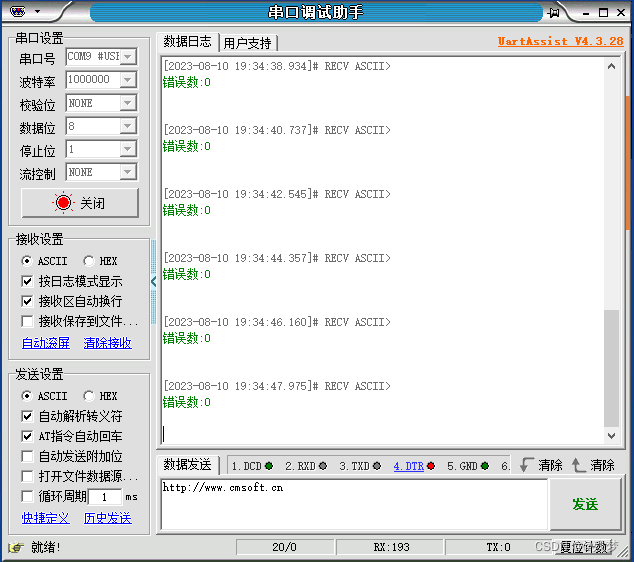
完整工程:
链接:https://pan.baidu.com/s/1SfxQO7QM_e1GsVD_yJOckg
提取码:hk7u






